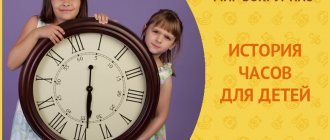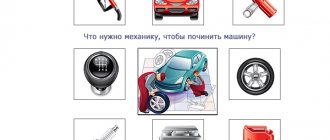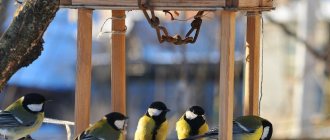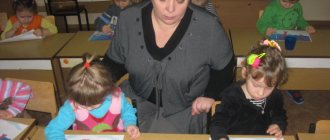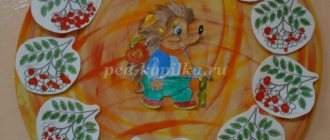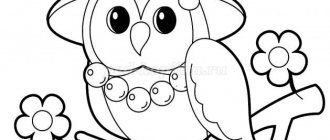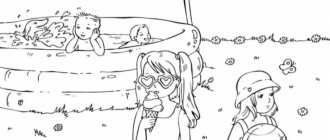Lesson: “Use of non-traditional artistic techniques in fine arts lessons”
Types and techniques of non-traditional artistic drawing
materials.
Poking with a hard, semi-dry brush.
Means of expression: texture of color, color.
Materials: hard brush, gouache, paper of any color and format, or a cut out silhouette of a furry or prickly animal.
Method of obtaining an image: the child dips a brush into the gouache and hits the paper with it, holding it vertically. When working, the brush does not fall into the water. In this way, the entire sheet, outline or template is filled. The result is an imitation of the texture of a fluffy or prickly surface.
Finger painting.
Means of expression: spot, dot, short line, color.
Materials: bowls with gouache, thick paper of any color, small sheets, napkins.
Method of obtaining an image: the child dips his finger in the gouache and puts dots and specks on the paper. Each finger is painted with a different color. After work, wipe your fingers with a napkin, then the gouache is easily washed off.
Palm drawing.
Means of expression: spot, color, fantastic silhouette.
Materials: wide saucers with gouache, brush, thick paper of any color, large format sheets, napkins.
Method of obtaining an image: a child dips his palm (the entire brush) into gouache or paints it with a brush (from the age of five) and makes an imprint on paper. They draw with both the right and left hands, painted in different colors. After work, wipe your hands with a napkin, then the gouache is easily washed off.
Imprint with cork.
Means of expression: stain, texture, color.
Materials: a bowl or plastic box containing a stamp pad made of thin foam rubber impregnated with gouache, thick paper of any color and size, cork stamps.
Method of obtaining an image: the child presses the cork to a stamp pad with paint and makes an impression on the paper. To obtain a different color, both the bowl and the stopper are changed.
Printed with potato stamps.
Means of expression: stain, texture, color.
Materials: a bowl or plastic box containing a stamp pad made of thin foam rubber impregnated with gouache, thick paper of any color and size, potato stamps.
Method of obtaining an image: the child presses the signet onto a stamp pad with paint and makes an impression on the paper. To obtain a different color, both the bowl and the signet are changed.
Foam imprint.
Means of expression: stain, texture, color.
Materials: a bowl or plastic box containing a stamp pad made of thin foam rubber impregnated with gouache, thick paper of any color and size, pieces of foam rubber.
Method of obtaining an image: the child presses the foam rubber onto a stamp pad with paint and makes an impression on the paper. To change the color, use another bowl and foam rubber.
Styrofoam impression.
Means of expression: stain, texture, color.
Materials: a bowl or plastic box containing a stamp pad made of thin foam rubber impregnated with gouache, thick paper of any color and size, pieces of foam.
Method of obtaining an image: the child presses the foam onto a stamp pad with paint and makes an impression on the paper. To get a different color, change both the bowl and the foam.
Imprint with eraser stamps.
Means of expression: stain, texture, color,
Materials: a bowl or plastic box containing a stamp pad made of thin foam rubber impregnated with gouache, thick paper of any color and size, stamps from an eraser (the teacher can make them himself by cutting a design on the eraser with a knife or razor blade).
Method of obtaining an image: the child presses the signet onto a stamp pad with paint and makes an impression on the paper. To change the color you need to take another bowl and signet.
Imprint with crumpled paper.
Means of expression: stain, texture, color.
Materials: saucer or plastic box containing a stamp pad made of thin foam rubber impregnated with gouache, thick paper of any color and size, crumpled paper.
Method of obtaining an image: a child presses crumpled paper onto a stamp pad with paint and makes an impression on the paper. To get a different color, change both the saucer and the crumpled paper.
Wax crayons + watercolor.
Means of expression: color, line, spot, texture. Materials: wax crayons, thick white paper, watercolor, brushes. Method of obtaining an image: the child draws with wax crayons on white paper. Then he paints the sheet with watercolors in one or more colors. The chalk drawing remains unpainted.
Candle + watercolor.
Means of expression: color, line, spot, texture. Materials: candle, thick paper, watercolor, brushes.
Method of obtaining an image: the child draws with a candle on paper. Then he paints the sheet with watercolors in one or more colors. The candle pattern remains white.
Screen printing.
Means of expression: stain, texture, color.
Materials: a bowl or plastic box containing a stamp pad made of thin foam rubber impregnated with gouache, thick paper of any color, a foam swab (a ball of fabric or foam rubber is placed in the middle of the square and the corners of the square are tied with thread), stencils made of oiled semi-cardboard or transparent films.
Method of obtaining an image: the child presses a signet or foam rubber swab onto a stamp pad with paint and makes an impression on the paper using a stencil. To change the color, take another swab and stencil.
Subject monotype.
Means of expression: spot, color, symmetry.
Materials: thick paper of any color, brushes, gouache or watercolor.
Method of obtaining an image: the child folds a sheet of paper in half and on one half of it draws half of the depicted object (objects are chosen symmetrical). After painting each part of the object while the paint is still wet, the sheet is folded in half again to make a print. The image can then be decorated by also folding the sheet after drawing several decorations.
Blotography is normal.
Means of expression: stain.
Materials: paper, ink or thinly diluted gouache in a bowl, plastic spoon.
Method of obtaining an image: the child scoops up gouache with a plastic spoon and pours it onto paper. The result is spots in a random order. Then the sheet is covered with another sheet and pressed (you can bend the original sheet in half, drip ink onto one half, and cover it with the other). Next, the top sheet is removed, the image is examined: it is determined what it looks like. The missing details are completed.
Blotography with a tube.
Means of expression: stain.
Materials: paper, ink or thinly diluted gouache in a bowl, plastic spoon, straw (drink straw).
Method of obtaining an image: a child scoops up paint with a plastic spoon, pours it onto a sheet, making a small spot (droplet). Then blow on this stain from a tube so that its end does not touch either the stain or the paper. If necessary, the procedure is repeated. The missing details are completed.
Blotography with a thread.
Means of expression: stain.
Materials: paper, ink or thinly diluted gouache in a bowl, plastic spoon, medium-thick thread.
Method for obtaining an image: the child dips a thread into the paint and squeezes it out. Then he lays out an image from a thread on a sheet of paper, leaving one end free. After this, another sheet is placed on top, pressed, holding it with your hand, and pulls the thread by the tip. The missing details are completed.
Spray
Means of expression: point, texture.
Materials: paper, gouache, hard brush, piece of thick cardboard or plastic (5x5 cm).
Method of obtaining an image: the child picks up paint on a brush and hits the brush on the cardboard, which he holds above the paper. Paint splashes onto the paper.
Leaf prints.
Means of expression: texture, color.
Materials: paper, leaves of various trees (preferably fallen), gouache, brushes.
Method of obtaining an image: the child covers a piece of wood with paints of different colors, then applies it to the paper with the painted side to obtain a print. Each time a new leaf is taken. The petioles of the leaves can be painted on with a brush.
Watercolor crayons.
Means of expression: spot, color, line.
Materials: thick paper, watercolor crayons, sponge, water in a saucer.
Method of obtaining an image: the child wets the paper with water using a sponge, then draws on it with crayons. You can use the techniques of drawing with the end of a chalk and flat. When the paper dries, it becomes wet again.
Poking.
Means of expression: texture, volume.
Materials: squares of colored double-sided paper (2x2 cm), magazine and newspaper paper (for example, for hedgehog needles), pencil, PVA glue in a bowl, thick paper or colored cardboard for the base.
Method of obtaining an image: the child places the blunt end of a pencil in the middle of a square of paper and turns the edges of the square onto the pencil with a rotational movement. Holding the edge of the square with a finger so that it does not slip off the pencil, the child dips it into the glue. Then he glues the square onto the base, pressing it with a pencil. Only after this does he pull out the pencil, and the folded square remains on the paper. The procedure is repeated many times until the desired amount of paper space is filled with folded squares.
Landscape monotype.
Means of expression: spot, tone, vertical symmetry, image of space in a composition.
Materials: paper, brushes, gouache or watercolor, damp sponge, tiles.
Method of obtaining an image: the child folds the sheet in half. On one half of the sheet a landscape is drawn, on the other half it is reflected in a lake or river (imprint). The landscape is done quickly so that the paints do not have time to dry. The half of the sheet intended for the print is wiped with a damp sponge. The original drawing, after a print is made from it, is enlivened with paints so that it differs more from the print. For monotype you can also use a sheet of paper and tiles. A drawing is applied to the latter with paint, then it is covered with a damp sheet of paper. The landscape turns out blurry.
